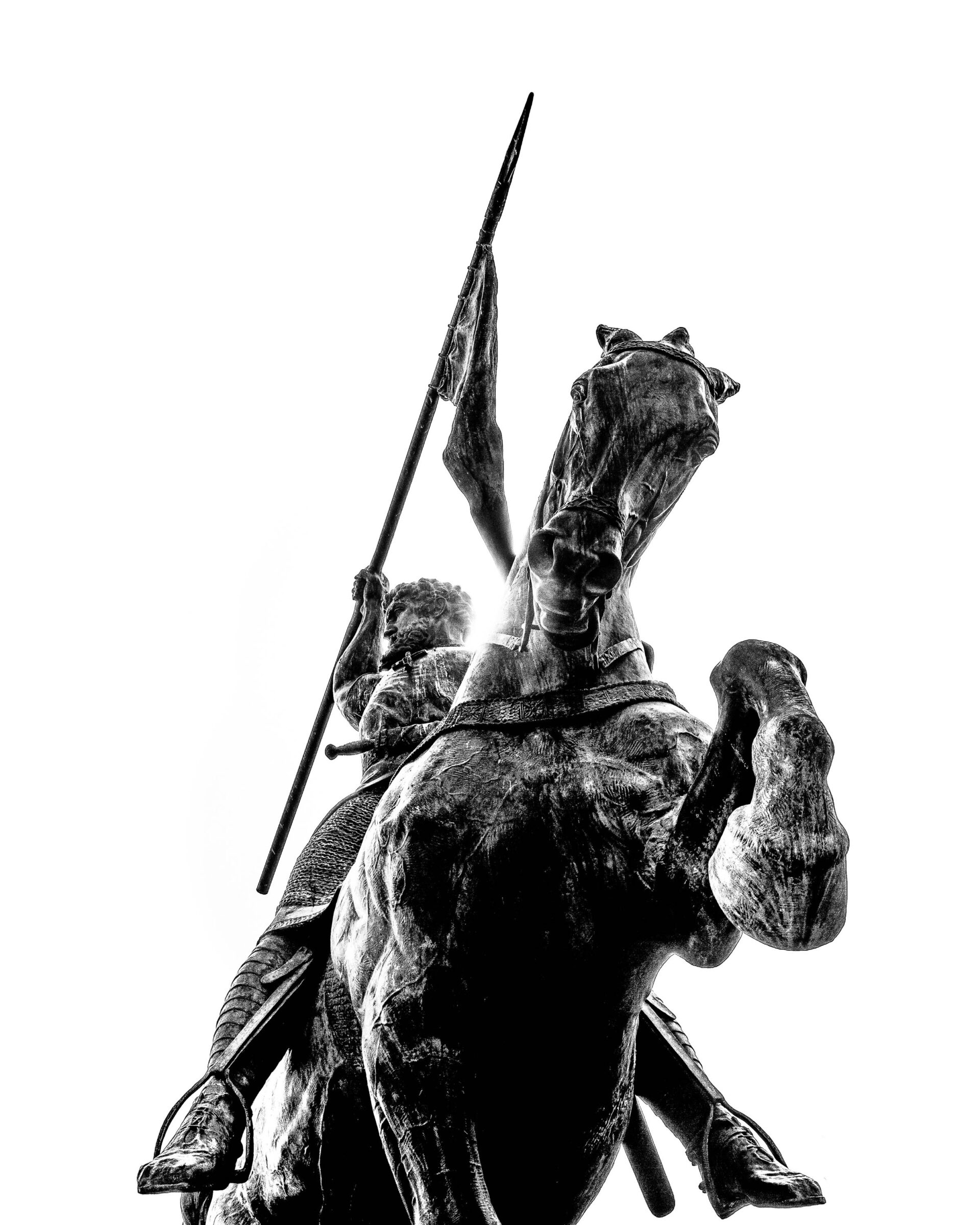
A couple of weeks ago I received an artist newsletter in my email that was discussing the issues surrounding the controversy about removing confederate monuments. The author describes a group of art conservators debating the merits of removing monuments that depict confederate military leaders. They acknowledge that public art can be an “instrument of power” while also contemplating the artistic merit of the monuments. One conservator remarked, “the sculptural rendering of that horse’s flank is magnificent!”
This got me thinking about my own experiences with public sculptures and how realism in art is predominately tied to a symbolic narrative that is ideologically based.
A sculpture of a soldier on a horse is connected to the creative arrangement of historic facts into a cultural narrative that validates the hegemony that the commission originates from.
In the case of the American civil war these monuments are glorifying the elite social class that exists on both sides of the battlefield. Most sculptures accentuate the message through the sheer weight in materials, the enormous financial investment, and the scale and proportion that dwarfs the person looking at it.
What I find so interesting is how these monuments with their loaded narratives draw us into a complicit relationship with the dominant culture’s attitudes and beliefs and how it happens without us necessarily being consciously aware of it and whether we like it or not.
As a caucasian child who grew up watching John Wayne cowboy movies that prominently featured his characters killing indians I was indoctrinated into what it meant to grow up and be a man in America. By playing cowboy and indians with other children I was unwittingly drawn into a dominant white culture that essentially created these narratives to celebrate the conquering of native people without acknowledgement of the genocide that had occurred.
The victorious are the ones that write the grade school history books that get taught to the youth who will grow up sharing in the racists beliefs without even knowing they are a prejudice. Public holidays such as Columbus day invite us to enjoy a day off of from school or work in exchange for implicitly agreeing with the violence towards indigenous cultures.
As magnificent as the sculpture at Mt. Rushmore/Six Grandfathers is, I cannot ignore the fact that it was forcibly located on sacred land that belonged to the Lakota Sioux who were driven out by Custer.
The need for cultural studies
It wasn’t until 1983 that cultural studies had even been identified as a distinct area of academic study by lecturer Stuart Hall. Without this area of inquiry I don’t think we can be aware of our own implicit bias that causes us to become accessories to acts of injustice. This bias is what allows us to teach history that includes the concepts of “manifest destiny” and “the lost cause” that seeks to whitewash the terrible parts of American history.
I remember taking my first graduate level course in cultural studies and realizing for the first time my own participation in a culture whose values that I did not agree with. It was as if a veil had been lifted and I could recognize the meta-narratives and the power structures that were put into place including public monuments and commissioned artworks.
Cultural studies and semiotics looked beyond politics and beyond the classical artifacts and official histories and described culture as, “experience lived, experience interpreted, experience defined.”
I keep this in mind whenever I photograph a sculpture. With each image I attempt to photograph in a way that reflects the interaction of the viewer and the sculpture. I am trying to show the relationship between the sculpture and our experience with it within the context of the public space it occupies.
In the case of the top photograph of a 23 foot bronze sculpture of El Sid by Anna Hyatt Huntington I am photographing from the front looking up at the horse and warrior that is astride it as you would see it standing in front of the tall concrete pedestal. The horse hooves are frightening and I am able to imagine the awesome violent force that it represents.
From this experience I try to imagine what it might be like for a person of color to have to navigate public spaces that have monuments to confederate officers on horseback that fought to try to preserve the inhumane institution of slavery.
I find it interesting that the majority of these monuments were funded and created in the early 1900’s during the era of Jim Crow laws rather than right after the war. They seem less of a tribute to the fallen and more of a warning to those seeking civil rights and equity. Some have argued that the confederacy lost the war but won the heart of America.
On the other side of the civil war monument debate are the statues commemorating Union officers that are controversial as well. Many of the monuments to Union officers are located out in the American West where these same officers took part in massacres of native tribes in an era where laws were written to legitimize the oppression of native people.
It seems as though the beauty and craftsmanship of these sculptures is able to disguise an ugly political ideology of racism, genocide, and segregation within the veil of classical art.
Constant exposure to these scenes with their plaques of false narratives of heroism and honor normalizes the beliefs and embeds them in the psyche of the citizens that seems to only become conscious when there is a threat to raze these symbols of hate and cruelty.
Public statues are often the tool of propaganda used in countries with oppressive governments. How many statues of Stalin were erected during his reign of terror?
Is Beauty Above Reproach?
Beauty by itself is not enough of a justification for our implicit approval of the embedded ideological messaging. The creation of a sculpture that is beautiful visually but ugly historically does not justify its continued existence within public spaces. Such statues should be remanded into the custody of museums that can provide context. Even that may be too much.
I cannot imagine a massive sculpture of Adolf Eichmann sitting astride on a horse at the Auschwitz Memorial Museum as not glorifying the Nazi history no matter how accurate the plaque.
Art doesn’t exist in a vacuum of beauty alone. It exists within a cultural context of contested ideology. Regardless of how beautiful the image and how profound the craftsmanship, I do not think we can condone the preservation of these images in public. All art takes on a linguistic quality and therefore public display outside places of academic study is communicating our endorsement for the ideology it represents.
In my opinion public art should be uplifting for all or it should at least represent an accurate history for all to understand.
In the case of civil war monuments, I think that Arlington National Cemetery should suffice as a public memorial.
As I review some of the imagery I have made of sculptures I think my photographs reveal the potential for art to be oppressive OR inspirational depending upon the context surrounding the subject matter.
An image of a Buddha within a peaceful and natural setting can symbolize a wisdom and compassion that transcends the harsh history of any one nation-state where buddhism is practiced. Just as I would hope a statue of the crucifix could transcend the history of the inquisitions and salem witch trials.
One of my favorite photographs of a statue is the Michael Anderson memorial. It is historical in nature but is also an inspirational tribute to mankind’s technical aspirations while also expressing reverence for all living things.
Summary
Realistic imagery is loaded with symbolism and as such is subject to interpretation and reinterpretation as a society hopefully evolves towards social justice and takes actions to insure the wellbeing for every member of the community.
Sculpture’s existence within public spaces that mandate a perpetual interaction with the people of the community should not be guaranteed and should be renegotiated by each subsequent generation.
I hope that we can evolve to a more equitable and just culture and that we can let go of the symbols that represent past atrocities in favor of public sculptures that can reflect the hopes and dreams of what we wish to become.

Sculptures featured in my photos top to bottom:
- El Cid (1927) by Anna Wyatt Hunnington
Bronze Sculpture located in San Francisco - Indian on Horseback (1898) by Alexander Phimister Proctor
Bronze sculpture on display at Portland Art Museum in 2012. - Amazarashi-No-Hotoke (1790)
Bronze Buddha Statue located in Golden Gate Park, San Francisco - Michael P. Anderson Memorial (2005) by Dorthy Fowler
8 foot tall bronze sculpture located in Spokane Washington
Citations:
“Act for the Government and Protection of Indians.” PBS, Public Broadcasting Service, www.pbs.org/wgbh/americanexperience/features/goldrush-act-for-government-and-protection-of-indians/.
Best, Ryan. “Confederate Statues Were Never Really About Preserving History.” FiveThirtyEight, 8 July 2020, projects.fivethirtyeight.com/confederate-statues/.
Genn, Sara. “Permanence.” The Painters Keys, 12 July 2020, painterskeys.com/permanence/.
Hsu, Hua. “Stuart Hall and the Rise of Cultural Studies.” The New Yorker, 2017, www.newyorker.com/books/page-turner/stuart-hall-and-the-rise-of-cultural-studies.
Patrick Cockburn @indyworld. “Patrick Cockburn: Trump’s Racism May Be Blatant but the Culture He Defends Encompasses Far More than Racial Division.” The Independent, Independent Digital News and Media, 3 July 2020, www.independent.co.uk/voices/trump-civil-war-racism-black-rights-guns-abortion-evangelical-a9599936.html.
Serwer, Story by Adam. “The Myth of the Kindly General Lee.” The Atlantic, Atlantic Media Company, 24 June 2020, www.theatlantic.com/politics/archive/2017/06/the-myth-of-the-kindly-general-lee/529038/.
team, ICT editorial. “A Different View of Mount Rushmore.” IndianCountryToday.com, Indian Country Today, 11 July 2020, indiancountrytoday.com/archive/a-different-view-of-mount-rushmore-rgresUhTKkSwAq9JtX17CQ#:~:text=Mount%20Rushmore%20was%20known%20to,asked%20what%20it%20was%20called.
